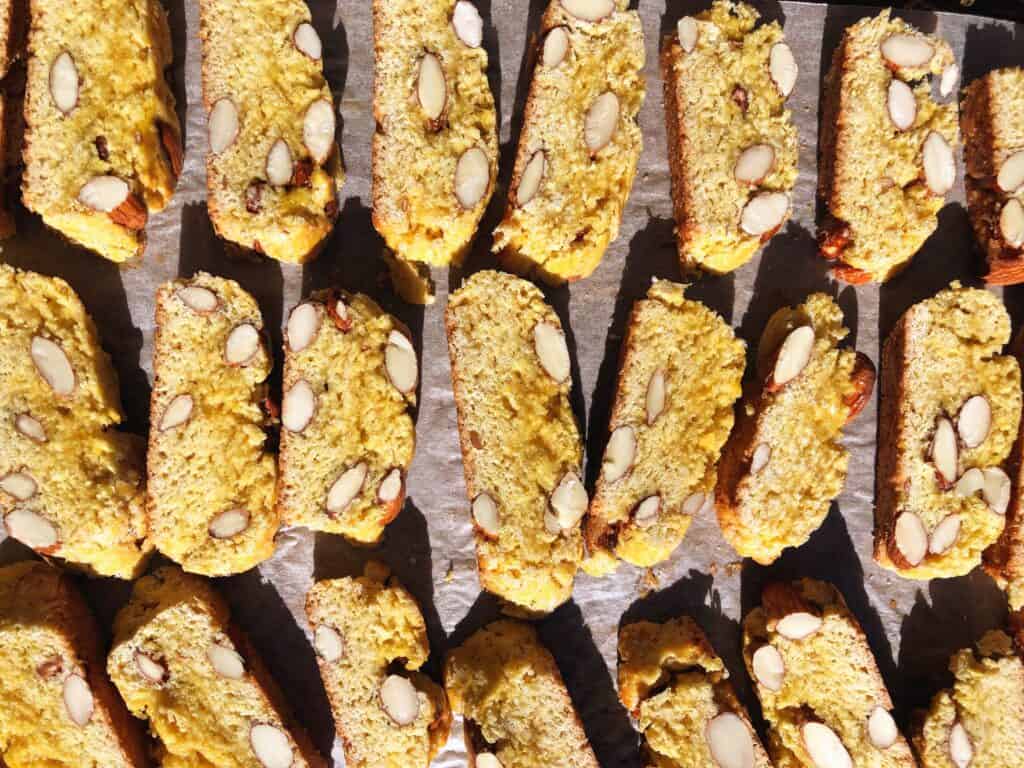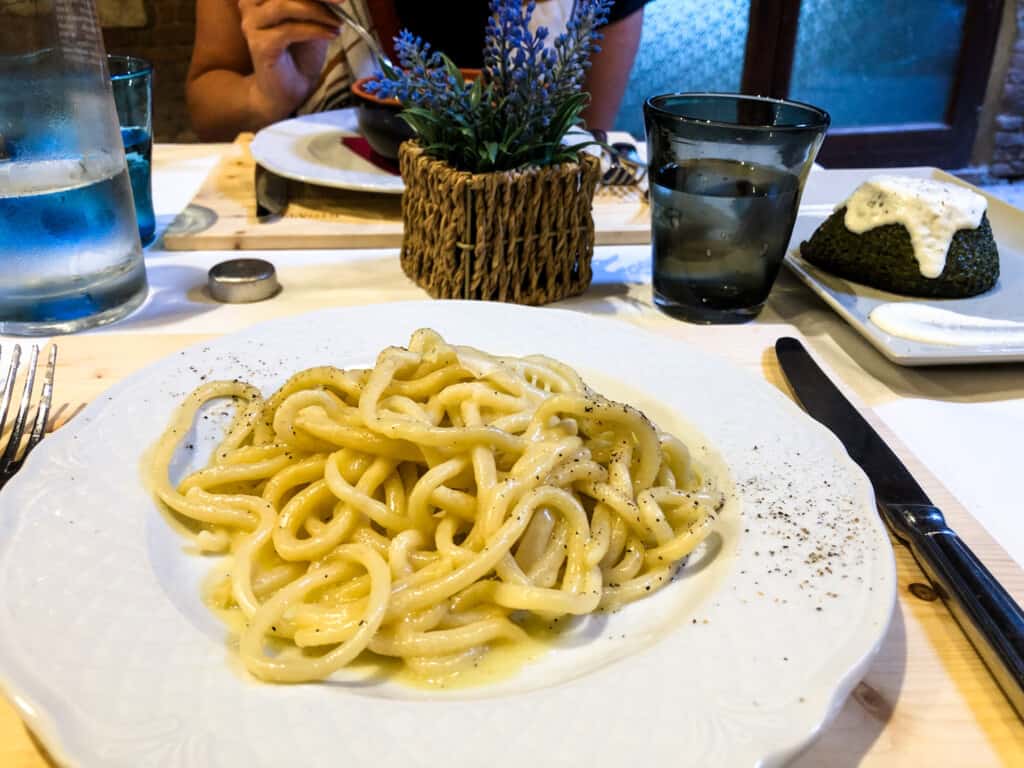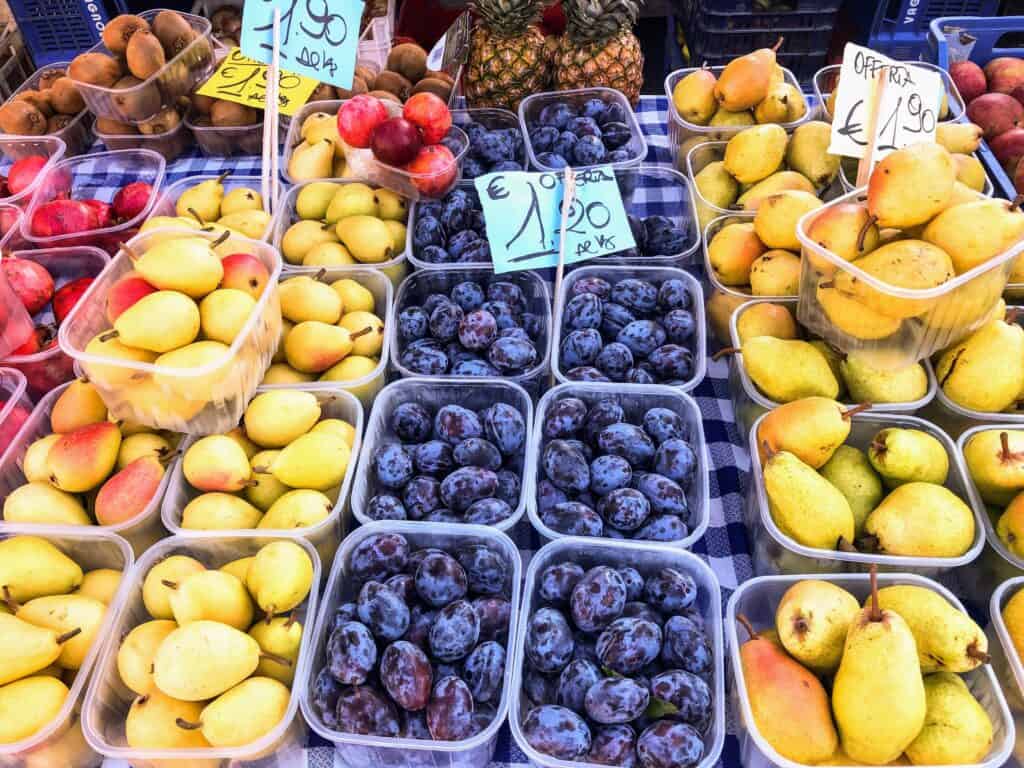Last updated on March 10th, 2024
Cantuccini (or cantucci) – you’ve likely enjoyed them and know of them as Italian biscotti.
These crunchy cookies are biscotti – the general term for cookies in Italian. Cantuccini are a type of biscotti made in Tuscany.
Nice To Know: Calling cantuccini ‘Italian biscotti’ is a bit like calling chocolate chip cookies ‘American cookies’ – they’re just one type of cookies you’ll find in America.
Cantuccini are cookies that I really never learned to love and appreciate until I moved to Florence. The truth is, they are pretty boring eaten alone, but they’re a great vehicle for coffee or booze (you are meant to dip them in Vin Santo or coffee to soften them up).
The original recipe from the city of Prato has changed a bit – in the beginning of the 19th century, it used pine nuts and didn’t include any baking powder. Today, cantuccini (Italian biscotti) are most commonly made with almonds and with the addition of baking powder.
This cantuccini recipe is loyal to the traditional one from Prato but I have included a ton of great suggestions to add additional flavor to these cookies. Use this very traditional Tuscan recipe as your go-to ‘Italian biscotti’ recipe (as we Americans refer to them). And if you like to experiment, this is the recipe for you!
Jump to Section
Cantuccini Pronunciation
Cantuccini is pronounced kahn-tooch-CHEE-nee in Italian.
Listen to the pronunciation of cantuccini:
What Are Cantuccini (aka Italian Biscotti)?

Cantuccini are a type of Italian biscotti (cookies) from Tuscany, specifically Prato, just outside of Florence. They are, however, known as biscotti in the English language and if we dissect the word bis (twice) and cotto (cooked) we see that these cookies are indeed twice-baked.
The cookies are first shaped into long logs, the size and width will determine the size of your cantucci (larger cookes) or cantuccini (smaller versions of cantucci), baked and then cut into slices and baked a second time until very hard, giving them a nice, long shelf life, ideal for dipping into coffee for breakfast or into sweet wine for dessert.
Ingredients for Cantuccini

Makes 30-40 cookies, depending on the size of your cantuccini. prep time 20 min. cook time 35 min
- 2 ½ scant cups all-purpose flour (300 g)
- ¾ cup (150 g) granulated sugar
- ¾ cup + 1 Tbsp (125 g) almonds
- 2 large eggs + 1 egg yolk for the egg wash
- ½ tsp baking powder
- 1 tablespoon Vin Santo
- a pinch of salt
Step-By-Step Instructions for Making Cantuccini (Italian Biscotti)

- Preheat the oven to 350 F (180 c) oven.
- In a large bowl or in a stand mixer, combine the flour, sugar, salt and baking powder.
- Add the eggs, one at a time followed by the Vin Santo. At first, it should look very crumbly, almost like a thick cornmeal. Once you start working it with your hands it will come together.
- Turn the dough out onto a clean surface and knead lightly with your hands until the dough comes together. If the dough is too dry and doesn’t come together into a ball add a teaspoon of water at a time until it does.
- Add the almonds and continue to knead until they are well incorporated into the dough. Keep in mind that it’s perfectly normal for the almonds to fall out as you start to work them in – just stuff them back into the side of the dough and keep kneading. Sometimes not all the almonds make it in because the dough is a bit dryer (depends on egg size and flour brand) and that’s perfectly fine.
- Dust your work surface lightly with flour (if the dough is sticking) and roll the dough into two logs about ¾ inch (2 cm) high and 1 ½ inch (4 cm) wide, slightly pressing them down on the top so they are slightly flattened.
- Arrange logs on a baking sheet at least 2-3 inches (5-8 cm) apart.
- Beat the remaining egg yolk with ½ teaspoon of water and brush all over the top and sides of the logs.
- Bake for 20-25 minutes until lightly brown.
- Remove and let cool for about 10 minutes. Cut into slices with a sharp knife slightly on the bias about ½ inch (1.5 cm).
- Return the cantuccini cut side up to the baking sheet and bake again for 10-15 minutes, checking to be sure they don’t burn on the bottom. When you take them out, they will still be soft but as they cool they will harden up.
- Transfer to a wire rack to cool.
Substitutions For Cantuccini

- Add another sweet wine instead of Vin Santo.
- Use baking flour (known as 00 flour in Italy) instead of all-purpose.
- Add 1 teaspoon vanilla instead of the Vin Santo.
- Add the zest of a lemon or orange for a citrusy kick (not very traditional but I do think it’s a nice addition)
- Think of these cookies as a blank canvas if you are feeling creative and want to create your own version of these cookies. Try adding less traditional flavors such as candied ginger or raisins. You could even dip or drizzle them with chocolate.
- Other ideas for substitutions:
- chocolate
- walnuts
- pistachios
- hazelnuts
- candied orange peel
Cantuccini Serving Suggestions

Since these cookies are quite hard they are meant to be dipped into something to soften them up a bit, lessening the likelihood of breaking your tooth (just kidding!).
Most traditionally they should be served with a small glass of Vin Santo, sweet Marsala wine or Passito (a sweet wine made from dried grapes). This being said, they are great with any drink. Tea, coffee, milk, you name it!
Cantuccini (Italian Biscotti) Notes and Tips

- Use room temperature eggs, if possible.
- Use an oven thermometer to be sure your oven temperature is accurate.
- If you find the dough is sticking to the board as you shape your logs, add an extra bit of flour.
- If the dough is too dry (which can happen depending on the type of flour and size of your eggs), try adding a Tablespoon or two of water to the dough.
- To make regular size cantucci, form thicker logs. You will need to increase the baking time for cantucci.
- If you plan on serving these to small children I suggest you roughly chop the nuts before adding them (you may be able to tell from my pictures that I did this because I have toddlers).


Authentic Cantuccini (Italian Biscotti) Recipe
Ingredients
- 2.5 scant cups all-purpose flour (300 g)
- 3/4 cup granulated sugar (150 g)
- 3/4 cup + 1 Tbsp almonds (125 g)
- 2 large eggs
- 1 egg yolk for egg wash
- 1/2 tsp baking powder
- 1 Tbsp Vin Santo
- 1 pinch salt
Instructions
- Preheat the oven to 350 F (180 c) oven.
- In a large bowl or in a stand mixer, combine the flour, sugar, salt and baking powder.
- Add the eggs, one at a time followed by the Vin Santo. At first, it should look very crumbly, almost like a thick cornmeal. Once you start working it with your hands it will come together.
- Turn the dough out onto a clean surface and knead lightly with your hands until the dough comes together. If the dough is too dry and doesn’t come together into a ball add a teaspoon of water at a time until it does.
- Add the almonds and continue to knead until they are well incorporated into the dough. Keep in mind that it’s perfectly normal for the almonds to fall out as you start to work them in – just stuff them back into the side of the dough and keep kneading. Sometimes not all the almonds make it in because the dough is a bit dryer (depends on egg size and flour brand) and that’s perfectly fine.
- Dust your work surface lightly with flour (if the dough is sticking) and roll the dough into two logs about ¾ inch (2 cm) high and 1 ½ inch (4 cm) wide, slightly pressing them down on the top so they are slightly flattened.
- Arrange logs on a baking sheet at least 2-3 inches (5-8 cm) apart.
- Beat the remaining egg yolk with ½ teaspoon of water and brush all over the top and sides of the logs.
- Bake for 20-25 minutes until lightly brown.
- Remove and let cool for about 10 minutes. Cut into slices with a sharp knife slightly on the bias about ½ inch (1.5 cm).
- Return the cantuccini cut side up to the baking sheet and bake again for 10-15 minutes, checking to be sure they don’t burn on the bottom. When you take them out, they will still be soft but as they cool they will harden up.
- Transfer to a wire rack to cool.
Notes
- Add another sweet wine instead of Vin Santo.
- Use baking flour (known as 00 flour in Italy) instead of all-purpose.
- Add 1 teaspoon vanilla instead of the Vin Santo.
- Add the zest of a lemon or orange for a citrusy kick (not very traditional but I do think it’s a nice addition)
- Think of these cookies as a blank canvas if you are feeling creative and want to create your own version of these cookies. Try adding less traditional flavors such as candied ginger or raisins. You could even dip or drizzle them with chocolate.
- Other ideas for substitutions:
- chocolate
- walnuts
- pistachios
- hazelnuts
- candied orange peel
- Use room temperature eggs, if possible.
- Use an oven thermometer to be sure your oven temperature is accurate.
- If you find the dough is sticking to the board as you shape your logs, add an extra bit of flour.
- If the dough is too dry (which can happen depending on the type of flour and size of your eggs), try adding a Tablespoon or two of water to the dough.
- To make regular size cantucci, form thicker logs. You will need to increase the baking time for cantucci.
- If you plan on serving these to small children I suggest you roughly chop the nuts before adding them (you may be able to tell from my pictures that I did this because I have toddlers).
Cantuccini Recipe FAQ
Cantuccini are what Americans refer to as Italian biscotti. Biscotti in Italian is the generic term for cookies. Cantuccini are a type of Italian biscotti.
The recipe doesn’t change but cantuccini really just means a smaller version of the cantucci cookie. It might be slightly more narrow and shorter.
They are the same as cantuccini but often in Prato you will hear them called this way as the locals like to be sure their city gets the credit for coming up with such a delicious treat.
Keep them in an airtight container for up to one month.
They are a savory version made with parmigiano-reggiano cheese and pistachios.




